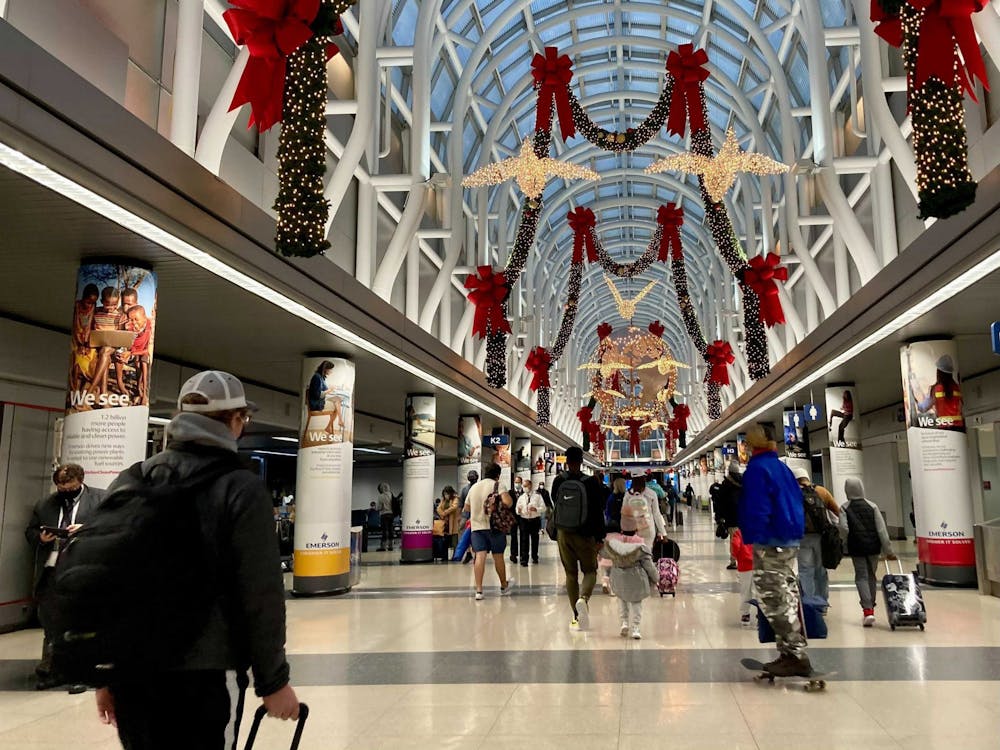By Kristen V. Brown
Bloomberg News
Coronavirus infections are already reaching unprecedented levels throughout the U.S. Now with Thanksgiving in the rearview mirror and Christmas and New Year's just around the curve, the question is: Just how much worse is the pandemic going to get?
The latest travel data out Monday suggest that things are looking grim. Between 800,000 and 1.1 million people flew in the days leading up to and after the holiday, according to data released by the Transportation Safety Administration. Though those numbers are a fraction of typical Thanksgiving travel patterns, they are far higher than public health officials and epidemiologists hoped to see.
Anthony Fauci, director of the National Institute of Allergy and Infectious Diseases, told ABC's "This Week" on Sunday that the U.S. may be about to see "a surge upon a surge." On CBS' "Face the Nation," Deborah Birx, the White House coronavirus response coordinator, said that Americans who traveled this past week should "assume that you were exposed and you became infected." She urged those that traveled to get tested within the next week.
The number of new COVID-19 cases in the U.S. topped 200,000 for the first time Friday. There have been more than 265,000 deaths. Last Wednesday, as millions had already begun their holiday travel, the Centers for Disease Control and Prevention forecast as many as 21,400 new deaths due to the virus over the next four weeks.
Ashish Jha, dean of Brown University's School of Public Health, said he suspects those numbers are not high enough.
"Every time I look at the data, it's worse," he said.
Jha says he expects the number of new deaths to be more in the range of 25,000 to 30,000 in the Thanksgiving aftermath.
"Things are going to be so bad over the next month," Jha said.
Exactly how bad it will get is difficult to say. Americans not only flew, but also drove to Thanksgiving celebrations. Before the holiday, the American Automobile Association predicted significant declines in bus, train and cruise travel, but only a slight drop in car travel. AAA said it would not have travel figures for the holiday anytime soon.
Car travel was projected to fall 4.3% from last year's pre-pandemic level, to 47.8 million travelers. With less travel this year by public transportation, AAA estimates driving will account for 95% of all holiday travel. On Monday, AAA said travel may have been less than initially forecast because of climbing infection rates and public health warnings. U.S. gasoline demand decreased 7.3% in seven days ending Nov. 28, according to GasBuddy, the travel and navigation app.
Even with a surge in online sales, some Americans still hit the road to shop. Chains with lines out the door included Lululemon Athletica Inc., Bath & Body Works and Urban Outfitters. Shoppers camped overnight in some locations of GameStop Corp., one of the few retailers to do brick-and-mortar releases of new video game consoles.
"This does have the potential to turn into another superspreader event," Doug Stephens, founder of consulting firm Retail Prophet, said of the shopping weekend.
The Trump administration had been sending out widely varying guidance on holiday travel in the weeks leading up to Thanksgiving, and only in the final week did the CDC overtly urge people to stay home. Many health policy experts say that was too little guidance, too late.
"We have not done nearly good enough a job in helping people understand the risk," said Michael Osterholm, director of the Center for Infectious Disease Research and Policy at the University of Minnesota and a member of President-Elect Joe Biden's virus taskforce. "The force of the virus right now is like a hurricane. But we are in control. We can flatten that curve."
In Canada, which celebrated Thanksgiving on Oct. 11, the average number of cases diagnosed each day more than doubled after the holiday, growing from 2,000 cases per day in mid-October to an average of 4,776 cases daily in the past week.
In the U.S., cases have risen after previous other holidays since the pandemic began.
"That does not bode well," said Caitlin Rivers, a professor at Johns Hopkins University who researches public health preparedness. "The winter holidays will just accelerate the winter trends we have already seen."
The CDC's forecast is an ensemble model that combines projections from 36 separate groups. Those forecasts range from 10,600 to 21,400 new deaths by Dec. 19. But Osterholm pointed out the numbers of deaths often lag by several weeks.
"The next three weeks are already a part of history," he said. "The challenge is what happens after that."
One group, the University of Washington's Institute for Health Metrics and Evaluation, publishes projections for further afield. It forecasts the number of deaths continuing to grow, reaching more than 470,000 by March 1, 2021. Projections that far out are subject to revision. Still, that's almost double the number of Americans the pandemic has killed so far.
Hospitals in many regions of the country, including the hard-hit Upper Midwest, are already near or beyond capacity. Anticipating a further surge, many have begun prepping tents and other temporary spaces to handle an influx of cases. Reports of doctors and nurses retiring early due to the pandemic are another worrisome signal. Even as equipment shortages have eased, some areas around the country now face a shortage of specialists who know how to operate vital equipment, such as breathing machines.
"Before the holiday we were already crowded in the hospital," said Janis Orlowski, chief healthcare officer for the American Association of Medical Colleges. There are already as many as 90,000 people hospitalized due to the virus, she said, and that number is expected to climb past 100,000. That's almost twice as many as there were on Nov. 1. "We don't know how big of a bump we're going to get, but we're bracing for a big bump," she said.




